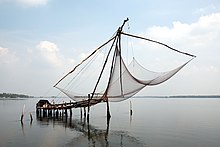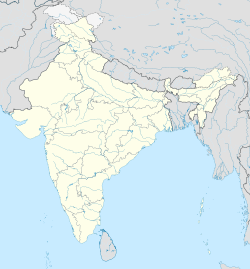Kochi (India)
| Kochi കൊച്ചി |
||
|---|---|---|
|
|
||
| State : |
|
|
| State : | Kerala | |
| District : | Ernakulam | |
| Location : | 9 ° 58 ' N , 76 ° 17' E | |
|
Inhabitants : - Agglomeration : |
601,574 (2011) 2,117,990 (2011) |
|
| Website : | cochinmunicipalcorporation.kerala.gov.in/ | |
Kochi ( Malayalam കൊച്ചി Kocci [ ˈkotʃi ] ), formerly Cochin [ / ˈkoʊtʃɪn / ], is a city in the state of Kerala in southern India , at a natural harbor on the Malabar coast . The city has around 600,000 inhabitants (2011 census), the metropolitan area around 2.1 million. This makes Kochi only the second largest city in Kerala, but the center of the largest metropolitan area in the state.
geography
Geographical location
Kochi is located in southwest India on the coast of the Arabian Sea , about 186 km north of Thiruvananthapuram , the capital of Kerala, and 361 km southwest of Bangalore . It belongs to the Ernakulam district of the state of Kerala.
City structure
The urban area extends both over the mainland and over several islands and peninsulas off the coast. The main districts are Ernakulam on the mainland, Fort Kochi , Mattancherry (both are located on a peninsula also called Fort Kochi), the artificially created island of Willingdon and the islands of Bolghatty, Vallarpadam and Vypeen.
climate
The climate in Kochi is tropical . The annual average temperature is 27.5 ° C. Due to the location by the sea, the temperatures fluctuate only slightly. The main rainy season lasts during the southwest monsoon from May to August, but the northeast monsoon from September to December also brings quite abundant rainfall. The rest of the year it is dry. The total amount of precipitation in one year is 2949 mm.
| Kochi | ||||||||||||||||||||||||||||||||||||||||||||||||
|---|---|---|---|---|---|---|---|---|---|---|---|---|---|---|---|---|---|---|---|---|---|---|---|---|---|---|---|---|---|---|---|---|---|---|---|---|---|---|---|---|---|---|---|---|---|---|---|---|
| Climate diagram | ||||||||||||||||||||||||||||||||||||||||||||||||
| ||||||||||||||||||||||||||||||||||||||||||||||||
|
Average monthly temperatures and rainfall for Kochi
Source: WMO
|
|||||||||||||||||||||||||||||||||||||||||||||||||||||||||||||||||||||||||||||||||||||||||||||||||||||||||
history
The rise of Kochi began with the destruction of the port of the ancient city of Muziris (today Kodungallur ), some 38 km away, by a flood disaster in 1341. However, it was precisely this flood that created the port basin of Kochi. From then on, the city developed into the most important port on the Indian west coast for the spice trade with China and the Middle East .
1500, two years after the arrival of the Portuguese navigator Vasco da Gama in Calicut (today's Kozhikode ), his compatriot Pedro Álvares Cabral landed in the lagoon of Kochi. In 1502, the Portuguese established their first trading post in the city and became the Portuguese’s first ally in India, although the city had been a vassal of Calicut until then . In 1503 the city was conquered and burned down by the army of the Samorin of Calicut. The population and the Raja of the city fled to the island of Vypin off the city until they were horrified by the newly arriving fleet under Afonso de Albuquerque . In 1503 the Portuguese built Fort Emmanuel to protect the city, the first European fortress on the Indian subcontinent . In 1504, the city and fortress under the command of Duarte Pacheco Pereira survived a siege by the army from Calicut, which is said to have included around 50,000 soldiers, 300 war elephants and 200 ships, and thus broke the power of Calicut. Vasco da Gama died in Kochi in 1524 and was buried there until his remains were transferred to Lisbon in 1539 . In the course of Portuguese colonial rule, the local rulers were increasingly disempowered and ultimately made vassals of the Europeans. Kochi became an important trading post in Portuguese India and was regularly visited by the Portuguese merchant fleets . The Indo-Portuguese Museum on Bishop-Kureethara-Road takes visitors back to this colonial era.
From 1653 the Dutch made serious competition to the Portuguese and finally conquered the city in 1663. Kochi flourished under the new rulers. The extensive trade network of the Dutch East India Company contributed significantly to the economic upturn.
In 1776 Kochi was devastated by the South Indian general Hyder Ali , later again by his son Tipu Sultan . Under the latter, the city temporarily came to Mysore .
In 1790 Kochi came under British influence. By the Anglo-Dutch Treaty of 1814 it was incorporated into the Madras Presidency and thus finally part of the British colonial empire. The British raised Willingdon Island in the 1920s to expand the port for ocean shipping.
From 1947 until it was incorporated into the newly created state of Kerala according to language borders in 1956, Kochi was the capital of the Union state of Cochin, as the city itself was officially called at that time. In 1996 it was given a name in Malayalam and has been called Kochi since then.
etymology
The origin of the name "Kochi" has not been clearly established, but the most common theory is that the name is derived from "kochazhi", which means "small lagoon" in Malayalam. Other theories say that the city owes its name to Chinese merchants or that the name comes from "kaci" (Malayalam: "port").
Culture
religion
The population is predominantly Hindu , but there are also many Christians ( Catholics , Thomas Christians and Protestants ) and Muslims , and to a lesser extent Jains and Sikhs also live in the city. The city's Jewish community is famous , but due to the heavy emigration to Israel it only has a few members (see Cochin Jews ).
Kochi is the seat of the Roman Catholic diocese of Cochin .
languages
The most important colloquial language is Malayalam . English is understood and spoken by many. There are also speakers of Tamil and many other, especially Dravidian , languages.
Attractions
Fort Kochi: The Franciscan Church (St. Francis Church) is the oldest church in India built by Europeans. It was built from wood in 1503, but renovated as a stone structure in the middle of the 16th century. Vasco da Gama was also buried here in 1524. His tombstone can still be seen there today, although his bones were transferred to Lisbon in 1539.
More recent is the Santa Cruz Basilica , also built in 1902 as a Catholic church and cathedral of the diocese of Cochin .
At the northern tip of the Fort Kochi peninsula are the famous Chinese fishing nets. They are said to have been introduced as early as the 13th century by Chinese merchants from the court of Kublai Khan . The heavy wooden structures on which nets hang are mainly used during floods. At least four men are required to handle them.
Mattancherry: The Mattancherry Palace, built by the Portuguese in the middle of the 16th century and given as a gift to the then Raja of Cochin, is located in this district . In return, he granted the Portuguese extensive trading privileges. The palace is built around a Hindu temple. The Dutch renovated and expanded the building in the 17th century, which is why it is also known as the Dutch Palace. In Mattancherry's Jewish quarter stands the synagogue , built in 1568 , which was partially destroyed by the Portuguese in 1662 , but was rebuilt two years later by the more tolerant Dutch. The interior is partly decorated with Chinese floor tiles.
Bolghatty Island: The main attraction of the island is the Dutch Bolghatty Palace from 1744. Confusingly, like the Mattancherry Palace, it is often referred to as the Dutch Palace.
Vypeen Island: The Portuguese fortress Palliport from the 16th century rises here. The Kochi lighthouse is also located on the Vypeen peninsula, to which there is a constant ferry connection from Kochi.
Kerala Folklore Museum: The Kerala Folklore Museum is a privately operated cultural institution for the documentation of South Indian architecture, art, handicrafts and theater.
Kochi in literature
The novel Des Moors Last Sigh by Salman Rushdie is largely set in Kochi.
Visual arts
The Kochi-Muziris Biennale has existed since 2012 and quickly established itself as one of the most important visual arts events in all of India.
Economy and Transport
economy

The city's main economic sectors are textile industry, shipbuilding, timber industry, fishing and coconut processing. Tourism plays an increasingly important role. The export economy is also of great importance. There are extensive port facilities on Willingdon Island, which make Kochi the most important port city in Kerala. There is also an Indian Navy base in the city . The government of the United Arab Emirates (UAE) has commissioned the construction of the SmartCity Kochi technology park. Kochi is the headquarters of Joyalukkas .
Start-up Village Kochi
The start-up Village Kochi was founded in April 2012. The goal was to create 1,000 technology start-ups over the next ten years, including at least one billion dollar company in India. The main focus is on student start-ups and innovations in telecommunications . It is India's first incubator to be jointly funded by public and private funds. Since October 2013, the start-up Village Kochi has supported 450 start-ups by combining incubation and virtual incubation. The Startup Village has set up a similar incubation facility in Visakhapatnam, Andhra Pradesh, called Sunrise Start-up Village. The data analytics company Unihalt is the first financially sustainable start-up to be supported by start-up Village Kochi.
Infrastructure
The main means of transport between the islands and peninsulas are ferries. However, Willingdon Island is connected to Ernakulam by the Venduruthy Bridge and to the Fort Kochi Peninsula by the Palluruth Bridge . There are good rail links from Ernakulam to the rest of the country. There are two train stations in Ernakulam: Ernakulam Junction and Ernakulam Town . There is also a connection for freight trains to Cochin Harbor Station on Willingdon Island. Kochi International Airport is just 30 km outside the city . A subway is under construction and should be completed by 2016.
sons and daughters of the town
- Aromar Revi (* 1961), climate scientist and author
- Gim (* 1981), German singer of Indian origin
- Asin Thottumkal (born 1985), actress
Web links
- Kochi Municipal Corporation (City Council)
- Side of the port of Kochi (English)
- Diocese of Cochin (English)
- Basilika Santa Cruz (English)
- Tourist information Fort Kochi (German / English)
Individual evidence
- ^ Census of India 2011: Provisional Population Totals. Cities having population 1 lakh and above. (PDF; 154 kB)
- ^ Census of India 2011: Provisional Population Totals. Urban Agglomerations / Cities having population 1 lakh and above. (PDF; 141 kB)
- ^ Searching for India's billion-dollar start-up , BBC. Retrieved July 23, 2019.
- ↑ Seaside 'village' in Kochi to nurture India's start-ups , Reuters, accessed July 23, 2019.
- ^ The Hindu, September 13, 2012: "Stone laying for Kochi Metro today".









